The Stone Pavilion Project
Learn More – History – Obscurity
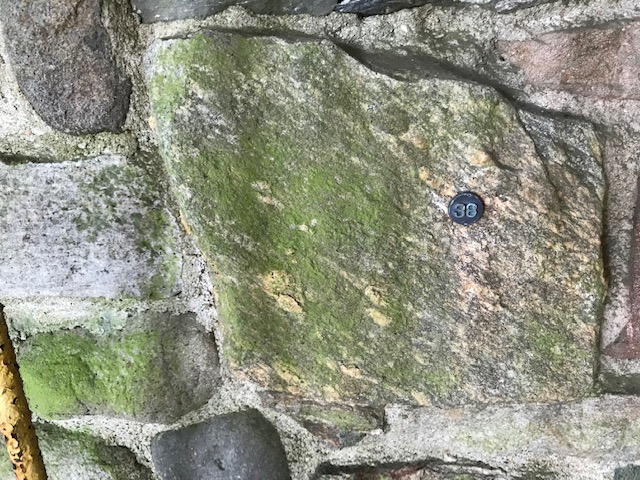
Losing Importance
On the grand day of celebration on May 16, 1837, the pavilion captured the attention of up to three thousand people. Almost immediately, its significance began fading as Connecticut State College transformed itself into a national university. With Governor Wilbur Cross's approval, and under President Jorgensen's leadership, its main focus began shifting away from practical education like agriculture to a much wider liberal arts agenda.
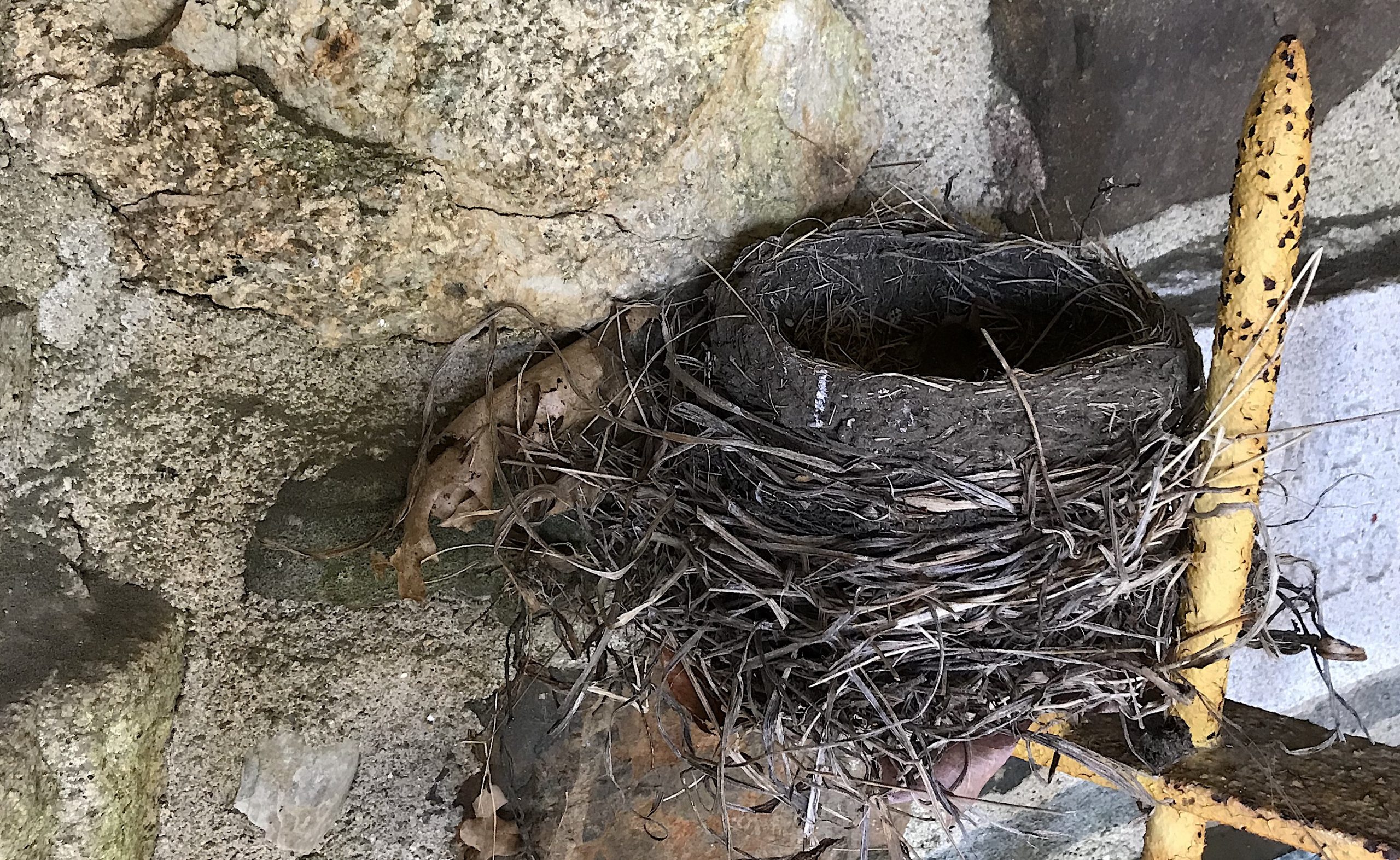
Lichens and moss began to cover the gray slate roof. The adjacent trees grew up, stretched their canopies, and cast this small building into the shade. Two residents of Storrs interviewed on May 3, 2023 recalled visiting the Pavilion in the late 1950s or earliest 1960s, reporting that it was nearly impossible to see from North Eagleville Road, given the dense growth of brush and foliage prior to the road widening project in 2017-2018. Additionally, being the size of a single colossal boulder only 14 feet across and 10 feet high, the pavilion is partly hidden by two other nearby boulders of comparable scale. By 2021, so few visitors were coming that birds were nesting in plain sight at eye level.
After 1937, the United States became increasingly distracted by the lead-up to World War II and its aftermath. Dedication of the pavilion coincided with Nazi Germany's opening of its first concentration camp, Buchenwald. America's postwar national economy continued to shift away from rural agriculture toward urbanization and industrialization. The value of farms fell and their number continued to decline steeply between the late 1930s and the 1950s. The U.S. farm population peaked in 1958, after which the membership and power of the national grange declined through the end of the millennium. As one measure of how unimportant the pavilion became, it wasn't mentioned in UConn's official institutional history --Bruce Stave's otherwise authoritative Red Brick in the Land of Steady Habits: Creating the University of Connecticut, 1881-2006.
After 21 years of having a complete collection of state stones, the collection became incomplete when Alaska became a state in 1958, and Hawaii in 1959. At some point, one stone from Alaska and one from Hawaii were mortared into the lower corners of the northwest and northeast corners of the exhibit wall, respectively. Their names and numbers, #49 and #50, were welded to the bronze plaque on a separate metal strip. The identifying bronze pin for Hawaii #50 is clearly visible. There is no bronze pin for Alaska, perhaps because the vein quartz was too hard to drill. We identified this stone as being linked to Alaska because, like Hawaii, it was the only other one mortared into the corner of the wall with newer cement at a level below the lowest row.
The iron grille was not part of the original structure. This is proven by the chiseling, drilling, and insertion of the brackets holding the grille into pre-existing and weathered walls. The lower left bracket of the grill is now completely detached owing to rust. Inserting the lower right required the partial destruction of a mortared stone (see photo below). An in-person memory by Storrs resident Holly Coppinger (written communication, May 5, 2023) confirms the absence of the grille when she visited "in 1958 or 1959, or possibly later (early '60s)." She also recalls seeing "the plaque in the middle of the stones where I could read it," which confirms the physical evidence of it having once been installed. It was from the now-missing plaque that she understood the purpose of the pavilion: "That's how I learned the stones represented the states." When I asked her on May 3, 2023 if she recalled seeing any names on the middle plaque, she responded "no." Another elderly witness from May 2023 recalled the presence of the plaque and the absence of the grill in the late 1950s or earliest sixties.

After its placement in the wall, the grill has been slowly deteriorating with rust to the extent that it has completely separated from the wall on the lower left (western) side. When the right side rusts enough, the grate will fall down. Only one coat of paint, now a dull yellow, has been found.
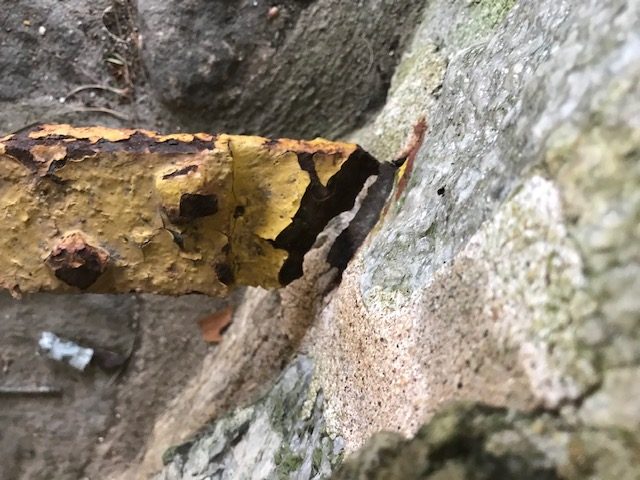
In August 1984, Thorson encountered the stone pavilion by happenstance. He remembers stepping inside, picking up a few empty beer cans for disposal, and sweeping some cigarette butts outside. He recalls seeing the dusty plaque with state numbers, looking briefly at the stones, and thinking that this was some sort of architectural folly. At the time, the specimen stones were covered by soot and grime and were overgrown with microbes, lichens, and algae. When he asked his geological colleagues in the former Department of Geology and Geophysics about the structure, he was told erroneously that it had been built by some faculty member from the school of agriculture who had collected stones from around the country.
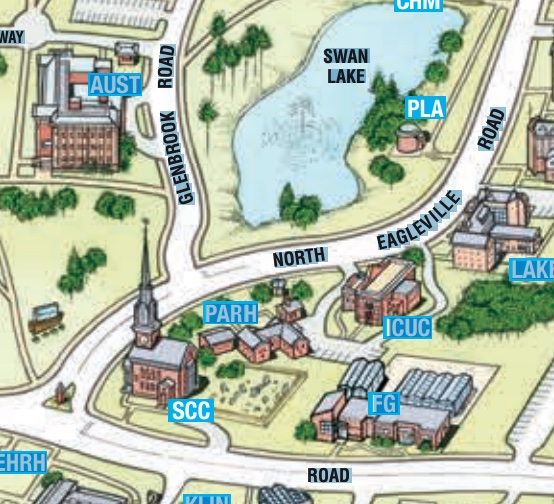
By 2013, UConn included the .
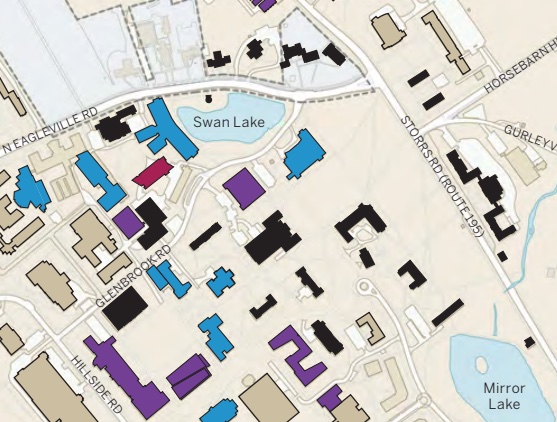
Found and Recovered
In 1997, UConn staff writer Mark Roy published a story about the structure titled "'Little Stone House' represents 50 states, pays tribute to Connecticut Agriculture" in the UConn Advance, the print-only predecessor to today's online internet magazine UConn Today. His article prompted Thorson to walk over and gave the pavilion a second look before dropping it. Fifteen years later in 2012, UConn Today reprinted Roy's article unchanged except for its new title "Little Stone House Turns 75." This reprint re-re-kindled my interest, which finally led to action.
The following year, Thorson decided to include it as a field trip stop for his Honors Core introductory geology course: ERTH 1055" Geoscience and he American Landscape. Though plainly visible from the main entrance road to north campus, only two students had ever noticed it, and none had visited. When tasked in 2014-2015 with designing a field trip for the high-enrollment geoscience courses (ERTH 1050 and 1052), he added the stone pavilion as a stop and summarized what little was known to help guide the teaching assistants for all 18 lab sections.
Owing to rising student interest, in May 2016, Thorson published the location and feature attraction of the stone Pavilion as one stop on an "Interactive Geological Tour," an interactive appendix for an article titled "Rock On" for UConn Magazine. Based on supportive comments from readers, he began talking it up with students and colleagues, and scheming for a larger project. In the summer 2018 issue of UConn Magazine, UConn writer Tom Breen published a short feature titled "Hidden UConn Quiz," with what he called a "hut" being one of the hidden attractions.
By the summer of 2020, Thorson decided to broaden the scope of interest beyond the geology classroom to create a permanent online exhibit for whomever might be interested. This was the birth of the Stone Pavilion Project. Aside from being a spectacular geology exhibit, the building is also a powerful symbol of the modern rebirth of agriculture, which is now shifting away from intensive scales and industrial techniques to more locally sourced, less polluting, and more sustainable methods that sequester more carbon in soils to mitigate climate change.
Called regenerative agriculture, this transition has captured the attention and hopes of young people everywhere. The stone pavilion can symbolize and energize this future promise because it was dedicated with the future in mind as "an enduring tribute to agriculture and to the tillers of the soil," and acknowledged as "not only as a tribute to Connecticut agriculture but to Connecticut Youth."